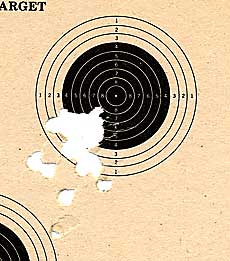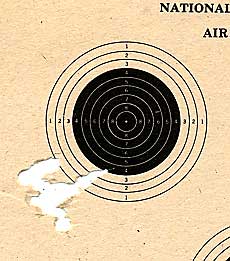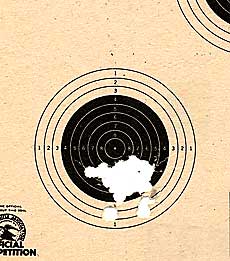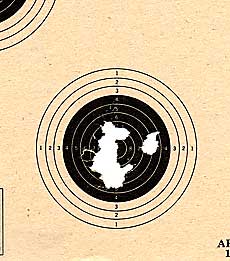by B.B. Pelletier
Today I test the Daisy Powerline 953 TargetPro for accuracy and right off the bat I have to disqualify the sights that come with the gun. They are fiberoptic, which cannot be precise under any circumstances, and this set seems extremely difficult to use. For hitting Coke cans they are fine and for clipping clothes pins they’ll work okay, but for precision shooting you can forget them. All I had to do was fire four shots to know I couldn’t use them.
Allow me to explain. For precision shooting you have to see the front sight in relation to both the rear notch and the target. A fiberoptic front bead looks as large as a beachball when trying to aim a rifle. Yes, you can get on target quickly and if hitting within one inch at 10 yards is all you want this is the way to do it. But when you don’t want to be off by more than a few hundredths of an inch forget fiberoptics, ’cause they aren’t that precise.
So I jumped ahead and mounted a 4-power scope. I will return and test the rifle with target sights in the future, but today I wasn’t ready to do that. The scope I used is a short one that left the loading port open for loading, which quickly became a chore with several types of pellets. More on that as we review the pellets.
The course
The 953 is a plinking rifle that some people use as an informal target rifle. So I shot off a rest at 10 meters. I decided to shoot 20-shot groups just because they worked so well with the U.S. Avenger 1100. Remember, this is not a test of target shooting. All we are looking at is group size from pellet to pellet. I kept the same aim point and just adjusted the scope knobs for each pellet.
RWS Club 10
The first pellet I tried was the RWS Club 10. It’s a utility pellet that 953 owners might select for plinking, so the results should prove interesting. The Club 10 was the hardest pellet to load of all four pellets tested. It tended to flip backwards on the loading ramp and didn’t always line up with the breech.

Beeman H&N Match
The next pellet I tried was the Beeman H&N Match. I expected to be blown away, but I wasn’t. The results were clearly better than the Club 10s, but nothing spectacular. These pellets also had some difficulty loading and tended to flip backwards in the loading port.

Gamo Match
I expected Gamo Match pellets to group larger than H&N Match, but they didn’t. Apparently this 953 likes them! They also had the same loading problems as the first two.

Getting tired?
By this point in the test I had fired 60 shots and was getting tired as many of you predicted. I therefore saved the pellet many feel to be the best in this rifle for last. No one can say I gave them special consideration.
RWS R-10 Match pellets
RWS R-10 Match pellets loaded without any problems. They are very smooth on the outside and didn’t seem to catch anything like the other pellets did. Please ignore the fact that they landed smack in the center of the black. That was just a coincidence, as all the pellets were fired after the scope was adjusted from a central aim point.

No comments?
Looks like a great value.
To those looking at the unimpressive groups, do not dispair. My 953 shoots much tighter groups, and this is with inexpensive Daisy and Crosman pellets.
However, to do it, I had to tune the trigger. The stock trigger was so rough and gritty that I was fighting the trigger and thus taking attention away from aiming the rifle. Well if you take attention away from aiming the rifle, you are not aiming the rifle and your shot will be off.
The fix is simple, and my beef with Daisy is, why don't they do it in the plant.
There are many posts on the internet about tuning the trigger of the x53 series rifles. Of them, the most important is to deburr and polish the trigger sear. Once you do that, the trigger pull becomes smooth, and you can concentrate on aiming the rifle.
CAUTION, when working on the trigger mechanism, you must be VERY CAREFUL to not change the angles of any of the sear surfaces, or round the sharp release edge of the sear and hammer. Only deburr and polish the surface.
– Gary
Get a copy if Tom Johnson’s Sporter Tips. Pages 4 and 5 cover upgrading the action to smoothen and lighten the trigger. The instructions are applicable to the Daisy 953. Just shortening the sear and trigger springs and installing a set screw to eliminate trigger slack, all simple procedures, produce dramatic improvements.